14.5 Surface Area
In Section 10.1 we used definite integrals to compute the arc length of plane curves of the form . We later extended these ideas to compute the arc length of plane curves defined by parametric or polar equations.
The natural extension of the concept of “arc length over an interval” to surfaces is “surface area over a region.”
Consider the surface over a region in the - plane, shown in Figure 14.5.1(a). Because of the domed shape of the surface, the surface area will be greater than that of the area of the region . We can find this area using the same basic technique we have used over and over: we’ll make an approximation, then using limits, we’ll refine the approximation to the exact value.
††margin:
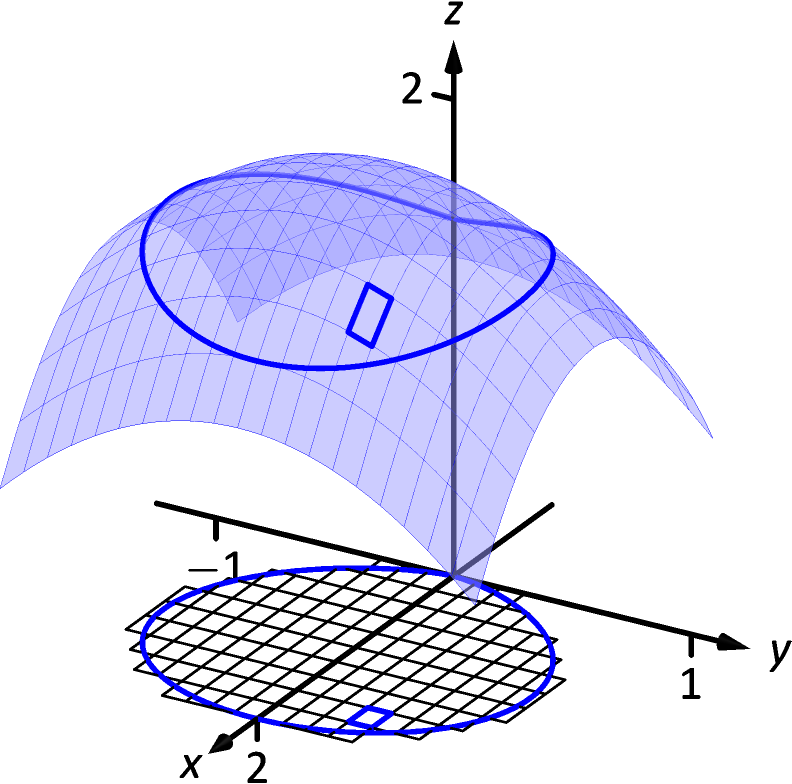 (a)
(a)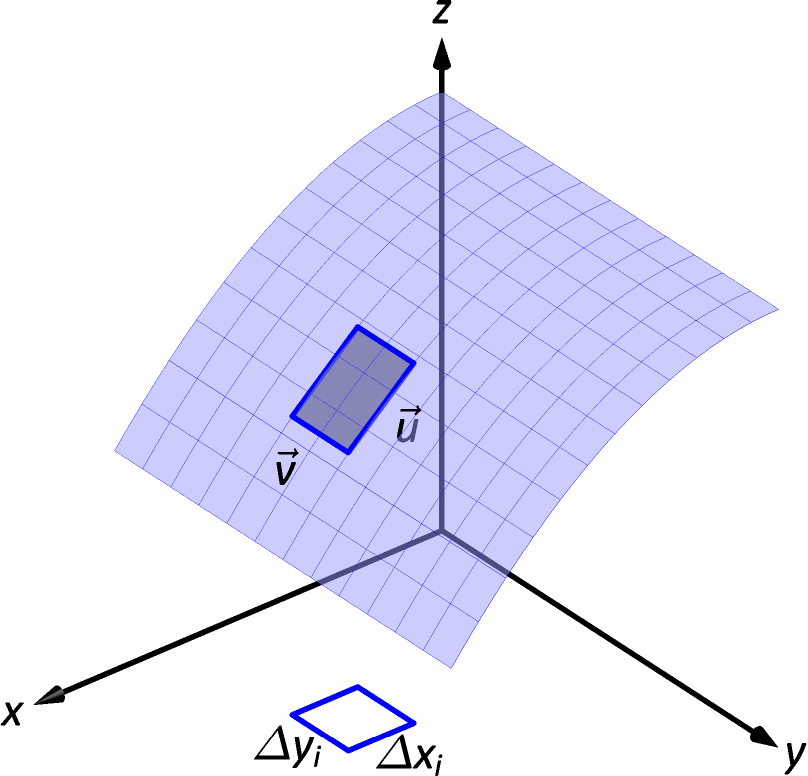 (b)
Figure 14.5.1: Developing a method of computing surface area.
(b)
Figure 14.5.1: Developing a method of computing surface area.
As done to find the volume under a surface or the mass of a lamina, we subdivide into subregions. Here we subdivide into rectangles, as shown in the figure. One such subregion is outlined in the figure, where the rectangle has dimensions and , along with its corresponding region on the surface.
In part (b) of the figure, we zoom in on this portion of the surface. When and are small, the function is approximated well by the tangent plane at any point in this subregion, which is graphed in part (b). In fact, the tangent plane approximates the function so well that in this figure, it is virtually indistinguishable from the surface itself! Therefore we can approximate the surface area of this region of the surface with the area of the corresponding portion of the tangent plane.
This portion of the tangent plane is a parallelogram, defined by sides and , as shown. One of the applications of the cross product from Section 11.4 is that the area of this parallelogram is . Once we can determine and , we can determine the area.
is tangent to the surface in the direction of , therefore, from Section 13.7, is parallel to . The -displacement of is , so we know that . Similar logic shows that . Thus:
| surface area | |||
Note that , the area of the subregion.
Summing up all of the approximations to the surface area gives
Once again take a limit as all of the and shrink to 0; this leads to a double integral.
Definition 14.5.1 Surface Area
Let where and are continuous over a closed, bounded region . The surface area over is
Watch the video:
Surface area of from https://youtu.be/ricG1_x6xCo
We test this definition by using it to compute surface areas of known surfaces. We start with a triangle.
Example 14.5.1 Finding the surface area of a plane over a triangle
Let , and let be the region in the plane bounded by , and , as shown in Figure 14.5.2. Find the surface area of over .
††margin:
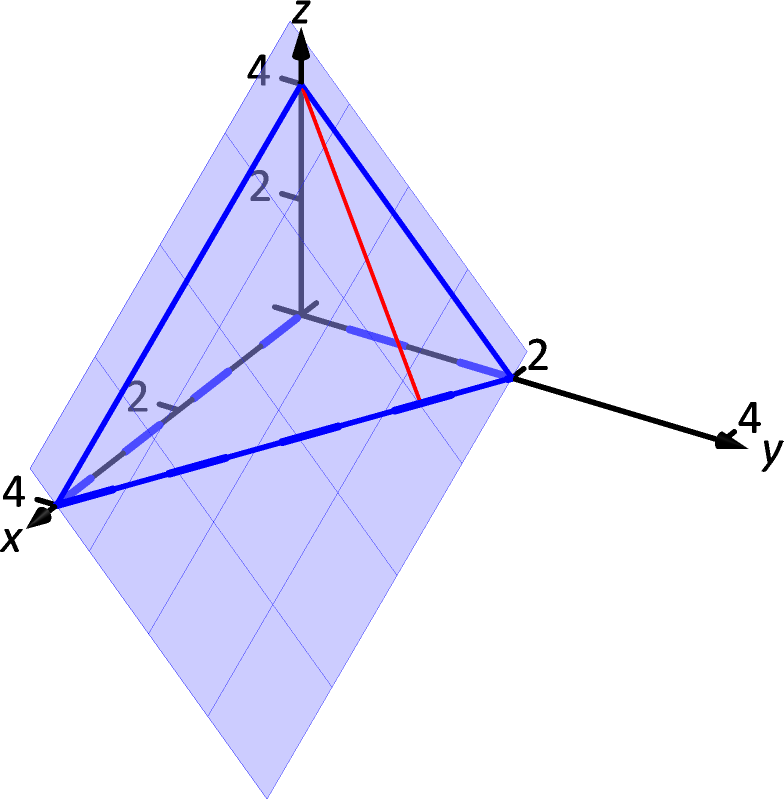 Figure 14.5.2: Finding the area of a triangle in space in Example 14.5.1.
Figure 14.5.2: Finding the area of a triangle in space in Example 14.5.1.
SolutionWe follow Definition 14.5.1. We start by noting that and . To define , we use bounds and . Therefore
Because the surface is a triangle, we can figure out the area using geometry. Considering the base of the triangle to be the side in the - plane, we find the length of the base to be . We can find the height using our knowledge of vectors: let be the side in the - plane and let be the side in the - plane. The height is then . Geometry states that the area is thus
We affirm the validity of our formula.
It is “common knowledge” that the surface area of a sphere of radius is . We confirm this in the following example, which involves using our formula with polar coordinates.
Example 14.5.2 The surface area of a sphere.
Find the surface area of the sphere with radius centered at the origin, whose top hemisphere has equation .
SolutionWe start by computing partial derivatives and find
As our function only defines the top upper hemisphere of the sphere, we double our surface area result to get the total area:
The region that we are integrating over is the disk, centered at the origin, with radius : . Because of this region, we are likely to have greater success with our integration by converting to polar coordinates. Using the substitutions , , and bounds and , we have:
| (14.1) | ||||
| Apply substitution and integrate the inner integral, giving | ||||
Our work confirms our previous formula.
Example 14.5.3 Finding the surface area of a cone
The general formula for a right cone with height and base radius , as shown in Figure 14.5.3, is
††margin:
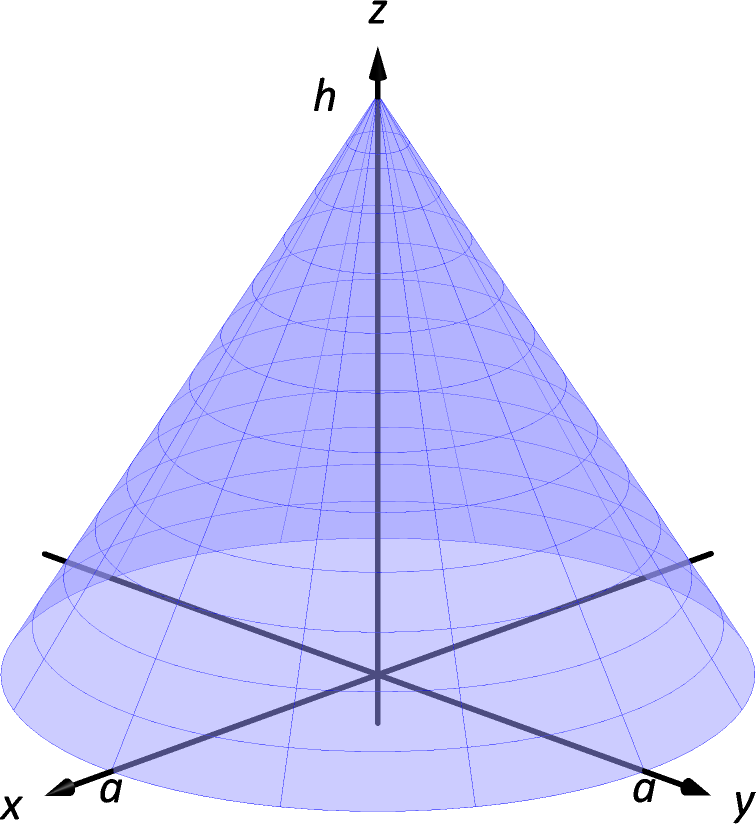 Figure 14.5.3: Finding the surface area of a cone in Example 14.5.3.
Figure 14.5.3: Finding the surface area of a cone in Example 14.5.3.
Find the surface area of this cone.
SolutionWe begin by computing partial derivatives.
Since we are integrating over the disk , we again use polar coordinates. Using the standard substitutions, our integrand becomes
This may look intimidating at first, but there are lots of simple simplifications to be done. It amazingly reduces to just
Our polar bounds are and . Thus ††margin: Note: Note that once again and are not continuous on the domain of , as both are undefined at . (A similar problem occurred in the previous example.) Once again the resulting improper integral converges and the computation of the surface area is valid.
This matches the formula found in the back of this text.
Example 14.5.4 Finding surface area over a region
Find the area of the surface over the region bounded by , , as pictured in Figure 14.5.4.
SolutionIt is straightforward to compute and . Thus the surface area is described by the double integral
††margin:
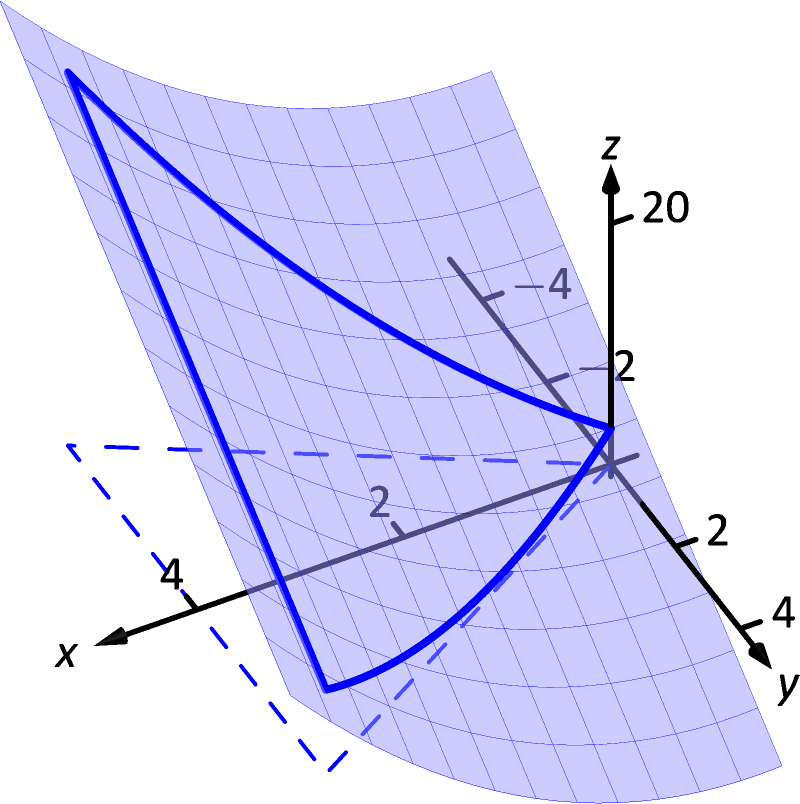 Figure 14.5.4: Graphing the surface in Example 14.5.4.
Figure 14.5.4: Graphing the surface in Example 14.5.4.
As with integrals describing arc length, double integrals describing surface area are in general hard to evaluate directly because of the square-root. This particular integral can be easily evaluated, though, with judicious choice of our order of integration.
Integrating with order requires us to evaluate . This can be done, though it involves Integration By Parts and . Integrating with order has as its first integral , which is easy to evaluate: it is simply . So we proceed with the order ; the bounds are already given in the statement of the problem.
| Apply substitution with : | ||||
So while the region over which we integrate has an area of , the surface has a much greater area as its -values change dramatically over .
In practice, technology helps greatly in the evaluation of such integrals. High powered computer algebra systems can compute integrals that are difficult, or at least time consuming, by hand, and can at the least produce very accurate approximations with numerical methods. In general, just knowing how to set up the proper integrals brings one very close to being able to compute the needed value. Most of the work is actually done in just describing the region in terms of polar or rectangular coordinates. Once this is done, technology can usually provide a good answer.
We have learned how to integrate integrals; that is, we have learned to evaluate double integrals. In the next section, we learn how to integrate double integrals — that is, we learn to evaluate triple integrals, along with learning some uses for this operation.
Exercises 14.5
Terms and Concepts
-
1.
“Surface area” is analogous to what previously studied concept?
-
2.
To approximate the area of a small portion of a surface, we computed the area of its plane.
-
3.
We interpret as “sum up lots of little .”
-
4.
Why is it important to know how to set up a double integral to compute surface area, even if the resulting integral is hard to evaluate?
-
5.
Why do and , for some real number , have the same surface area over a region ?
-
6.
Let and . Why is the surface area of over a region not twice the surface area of over ?
Problems
In Exercises 7–10, set up the iterated integral that computes the surface area of the given surface over the region .
-
7.
; is the rectangle with bounds , .
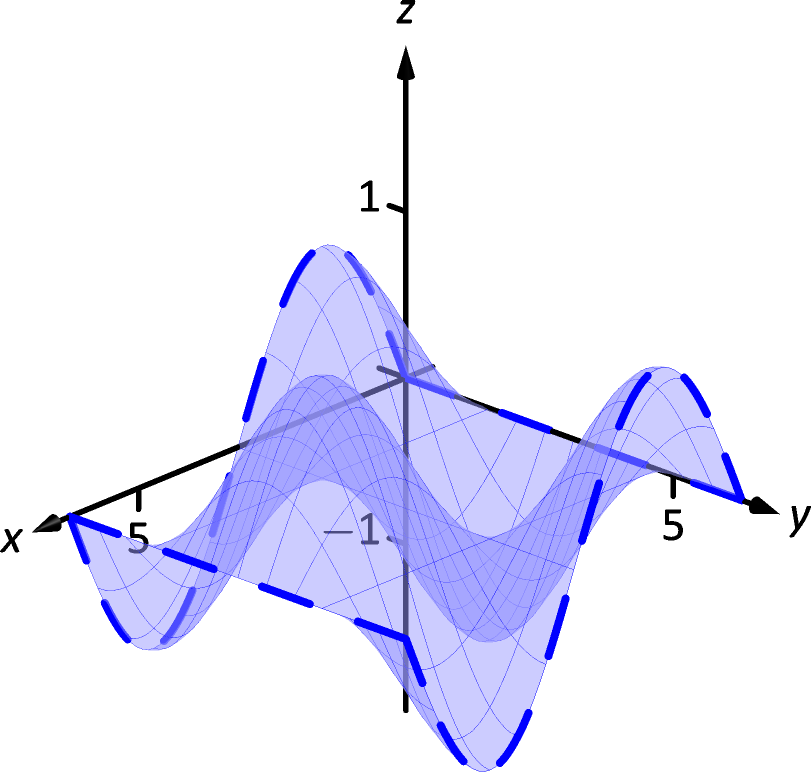
-
8.
; is the disk .
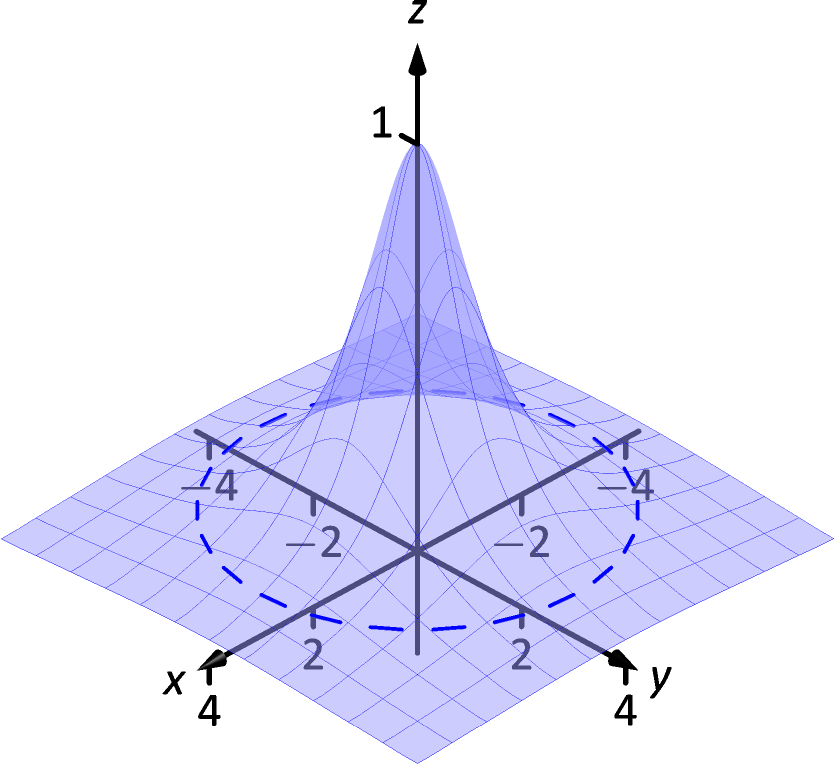
-
9.
; is the rectangle with opposite corners and .
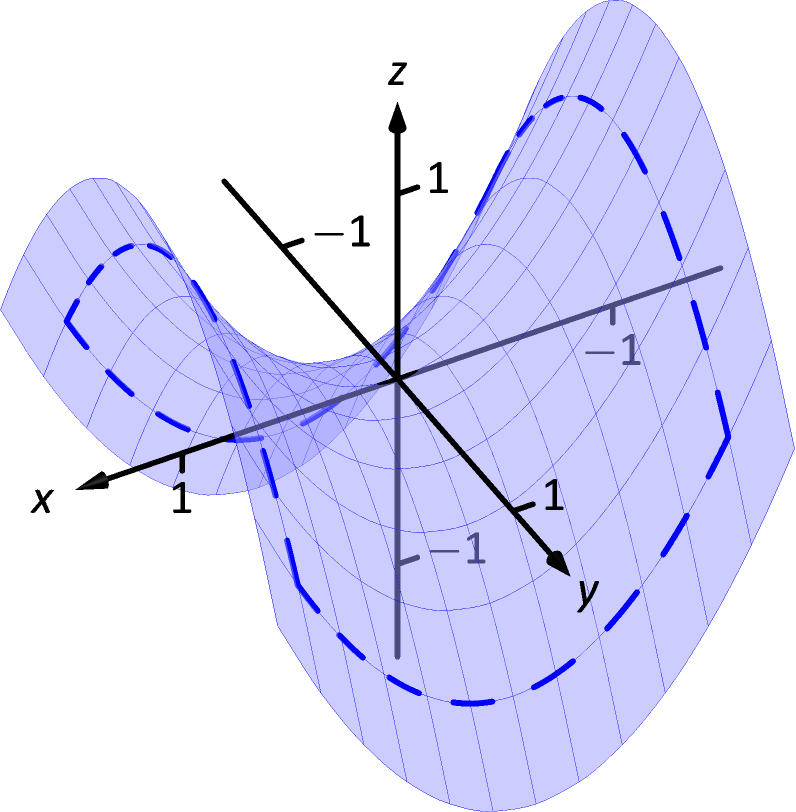
-
10.
; is the rectangle bounded by and .
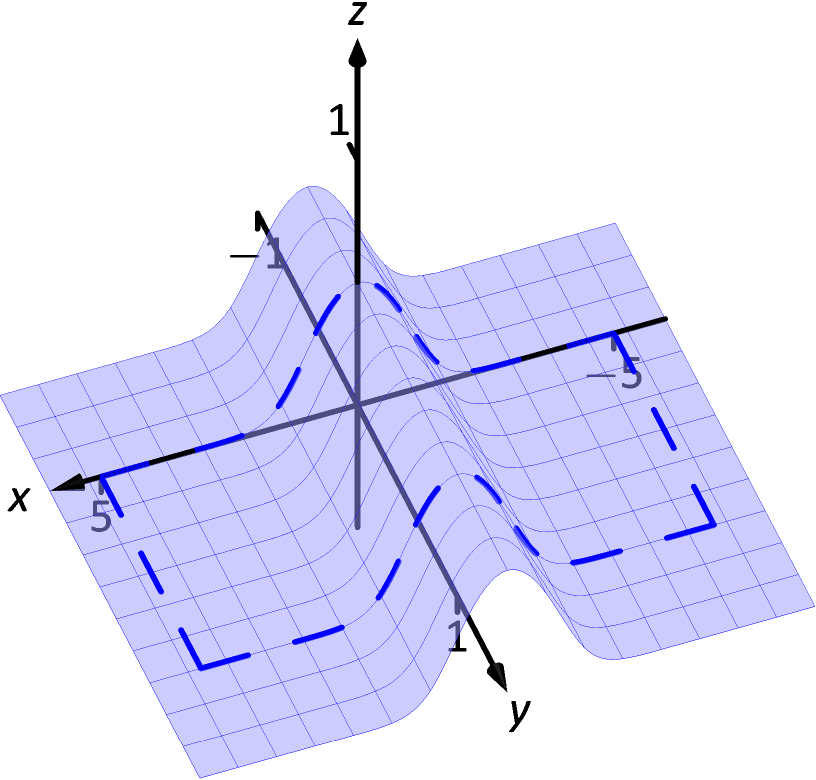
In Exercises 11–18, find the area of the given surface over the region .
-
11.
; is the rectangle with opposite corners and .
-
12.
; is the triangle with corners , and .
-
13.
; is the disk .
-
14.
over , the triangle bounded by , , .
-
15.
over , the rectangle with opposite corners and .
-
16.
over , the disk . (This is the cone with height 10 and base radius 5; be sure to compare your result with the known formula.)
-
17.
Find the surface area of the sphere with radius 5 by doubling the surface area of over , the disk . (Be sure to compare your result with the known formula.)
-
18.
Find the surface area of the ellipse formed by restricting the plane to the region , the disk , where , and are some constants. Your answer should be given in terms of and ; why does the value of not matter?
